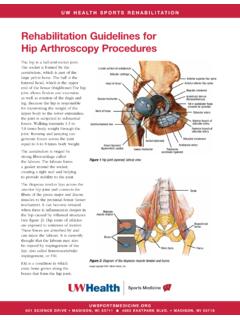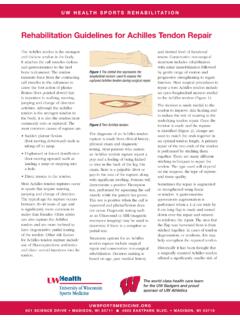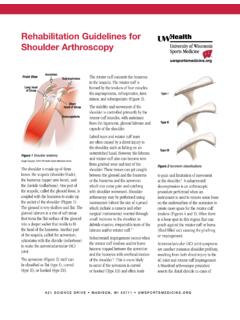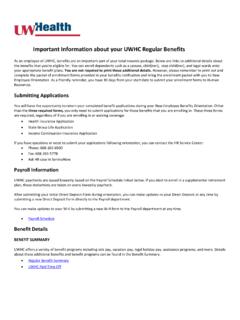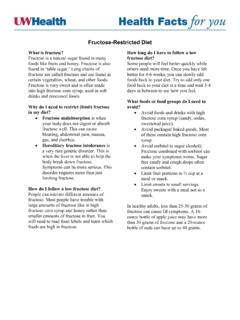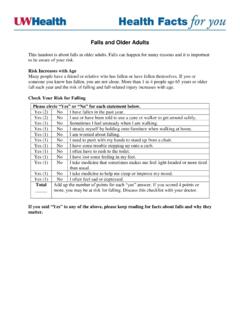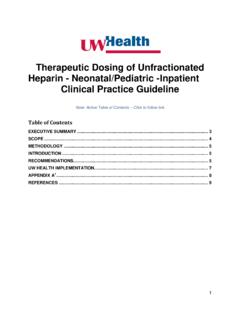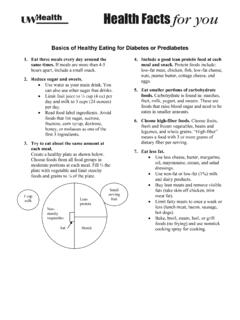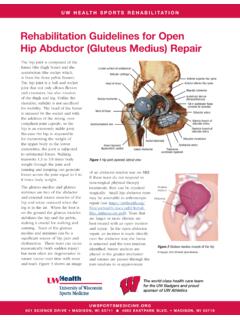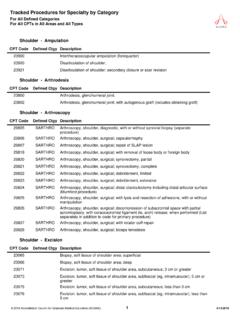Transcription of Rehabilitation Guidelines For SLAP Lesion Repair - UW Health
1 621 Science Drive MaDiSon, Wi 53711 Guidelines For slap Lesion RepairThe anatomic configuration of the shoulder joint (glenohumeral joint) is often compared to a golf ball on a tee. This is because the articular surface of the round humeral head is approximately four times greater than that of the relatively flat shoulder blade face (glenoid fossa)1 (Figure 1). The stability and movement of the shoulder is controlled by the rotator cuff muscles, as well as the shoulder ligaments, the capsule of the shoulder and the glenoid labrum. The labrum is a fibrocartilagenous ring which attaches to the bony rim of the glenoid The labrum doubles the depth of the glenoid fossa to help provide An analogy would be a parked car on a hillside with a block under the tire the round tire being the humeral head, the road being the glenoid fossa and the block being the labrum also serves as the anchor for the long head of the biceps.
2 A large portion of the long head of the biceps originates from the top (superior) portion of the labrum. Overhead sports can create significant forces at this attachment site. This can ultimately lead to injury and tears of the biceps off this attachment. This is called a slap Lesion (Superior Labral Anterior to Posterior tear). These injuries can also occur from trauma, such as falling on your arm, bracing your arm in an accident, arm tackling in football or any large sudden force applied to the arm. There are four basic types of slap A Type II slap tear is the most common type of slap tear requiring surgical reconstruction (Figure 2).3 In this type of tear the long head of the biceps remains attached to the labrum but the labrum has been detached from the Bicipital grooveGlenoid fossaScapulaHumeral headFigure 1 Anatomical configuration of the shoulder joint (glenohumeral joint)Reprinted with permission from Primal Pictures, Ltd.
3 ( ). Unauthorized use of this image is 2-A through 2-D The classification system for slap lesions. Figure 2-A A Type-I slap Lesion consists of degenerative fraying on the inner margin of the superior aspect of the labrum. Figure 2-B With a Type-II slap Lesion , the biceps attachment and the adjacent superior aspect of the labrum have pulled off the superior glenoid tubercle. Figure 2-C A Type-III slap Lesion is a superior labral bucket-handle tear. Figure 2-D A Type IV slap Lesion is a superior labral bucket-handle tear that extends Into the biceps permission for illustrations and photos is granted by The Journal of Bone and Joint Surgery, Inc. The copyright is owned by The Journal of Bone and Joint Surgery, Science Drive MaDiSon, Wi 53711 Guidelines For slap Lesion repair2bony This is repaired surgically by placing suture anchors (Figure 3) in the glenoid fossa, passing sutures through the labrum and then tying special surgical knots to approximate the labrum back to the bony glenoid return to throwing and contact sports occurs in 80-90% of , 5 Successful return to sport and activity is dependent on following post-operative precautions and completing a structured post-operative Rehabilitation program.
4 Our Rehabilitation program is outlined below. The Rehabilitation Guidelines are presented in a criterion based progression. General time frames are given for reference to the average, but individual patients will progress at different rates depending on their age, associated injuries, pre-injury Health status, Rehabilitation compliance and injury severity. These factors will also affect how long it takes each individual to meet the required criteria for return to sport and 3. The first illustration shows a Type II slap tear extending from 10:00 to 2:00. The second illustration shows this tear repaired with sutures and anchors anterior to and posterior to the long head of the biceps. The number of suture anchors needed varies from case to Science Drive MaDiSon, Wi 53711 Guidelines For slap Lesion repair3 PHASE I (Surgery to 4-6 weeks after surgery)Appointments Rehabilitation appointments begin within 7 days of surgery, continue 1-2 times per week Rehabilitation Goals Protection of the post-surgical shoulder Activation of the stabilizing muscles of the glenohumeral and scapulo-thoracic jointsPrecautions Sling immobilization required for soft tissue healing Hypersensitivity in axillary nerve distribution is a common occurrence No long head biceps tension for 6 weeks to protect repaired tissues this includes avoiding range of motion with long lever arm shoulder flexion, as well as resisted supination or elbow flexion Limit external rotation to 40 in neutral for the first 4 weeks.
5 Avoid abduction and external rotation for 6 weeks No extension or horizontal abduction past body for 4 weeks Dr. Scerpella s patients should also avoid forward flexion past 130 for 6 of Motion Exercises (Please do not exceed the range of motion specified for each exercise and time period) Gentle active/active assistive range of motion for elbow and wrist Pain free, gentle passive range of motion for shoulder flexion, abduction, internal rotation and external rotation within the limits of the Therapeutic Exercise Begin week 3, sub-maximal shoulder isometrics for internal rotation, external rotation, abduction and adduction within the limits of the precautions Hand gripping Cervical spine and scapular active range of motion Desensitization techniques for axillary nerve distributionCardiovascular Fitness Walking, stationary bike - sling on No treadmill (Avoid running and jumping due to the distractive forces that can occur at landing)
6 PHASE II (begin after meeting Phase I criteria, usually 6 to 12 weeks after surgery)Appointments Rehabilitation appointments are once every 1-2 weeks Rehabilitation Goals Full active range of motion Full rotator cuff strength in a neutral positionPrecautions Gradual initiation of biceps tension from weeks 6-8 to protect repaired tissues No passive range of motion for abduction with external rotation or extensionRange of Motion Exercises (Please do not exceed the range of motion specified for each exercise and time period) Active range of motion for shoulder flexion in side lying to lessen biceps tension Active range of motion for shoulder abduction in supine or prone to lessen biceps tension Active range of motion for shoulder internal rotation avoid internal rotation up the back type stretching since internal rotation and extension may place too much stress on the healing superior labrum621 Science Drive MaDiSon, Wi 53711 Guidelines For slap Lesion repair4 Suggested Therapeutic Exercise Scapular squeezes Internal and external rotation in neutral with exercise band resistance to neutral make sure patient is not supinating with external rotation movementCardiovascular Fitness Walking, stationary bike without using arms (No Airdyne) No treadmill, swimming or runningPHASE III (begin after meeting Phase II criteria, usually 10 weeks after surgery)
7 Appointments Rehabilitation appointments are 1-2 times per weekPhase III Goals Full active range of motion in all cardinal planes with normal scapulo-humeral movement Normal (rated 5/5) rotator cuff strength at 90 of shoulder abduction in the scapular plane Normal (rated 5/5) peri-scapular strengthPrecautions All exercises and activities to remain non-provocative and low to medium velocity Avoid activities where there is a higher risk for falling or outside forces to be applied to the arm No swimming, throwing or overhead sports Patients can develop posterior capsule tightness that inhibits Rehabilitation progress; continue to evaluate for this and treat if necessarySuggested Therapeutic ExerciseMobilization and motion Posterior glides and sleeper stretch if posterior capsule tightness is present upon assessmentStrength and Stabilization Flexion in prone, horizontal abduction in prone, full can exercise, D1 and D2 diagonals in standing Theraband/cable column/ dumbbell (light resistance/high repetition) internal rotation and external rotation in 90 of abduction Rowing with Theraband or resistance machines Balance board in push-up position (with rhythmic stabilization), prone Swiss ball walk-outs, rapid alternating movements in supine, and D2 diagonal closed kinetic chair stabilization with narrow base of supportCardiovascular Fitness Walking, biking, stairmaster and running (if Phase II criteria are met)
8 No swimmingProgression Criteria Patient may progress to Phase IV if they have met the above stated goals and have no apprehension, internal impingement or active irritation/inflamation of the long head of the biceps621 Science Drive MaDiSon, Wi 53711 Guidelines For slap Lesion repair5 PHASE IV (begin after meeting Phase III criteria, usually 16 weeks after surgery)Appointments Rehabilitation appointments are 1 time every 3 weeksPhase IV Goals Patient to demonstrate stability with higher velocity movements and change of direction movements Normal (rated 5/5) rotator cuff strength with multiple repetition testing at 90 of shoulder abduction in the scapular plane Full multi-plane active shoulder range of motionPrecautions Progress gradually into provocative exercises by beginning with low velocity, known movement patternsSuggested Therapeutic ExerciseMobilization and motion Posterior glides and sleeper stretch if posterior capsule tightness is present upon assessment Strength and Stabilization Dumbbell and medicine ball exercises that incorporate trunk rotation and control with rotator cuff strengthening at 90 of shoulder abduction.
9 Begin working towards more functional activities by emphasizing core and hip strength and control with shoulder exercises Theraband/cable column/ dumbbell internal rotation and external rotation in 90 of abduction Rowing with Theraband or resistance machines Higher velocity strengthening and control, such as inertial, plyometrics and rapid exercise band drills. Plyometrics should start with 2 hands below shoulder height and progress to overhead, then back to below shoulder with one hand, progressing again to overhead Begin education in sport specific biomechanics with very initial program for throwing, swimming or overhead racquet sportsCardiovascular Fitness Walking, biking, stairmaster and running (if Phase III criteria are met) No swimmingProgression Criteria Patient may progress to Phase V if they have met the above stated goals and have no apprehension or internal impingement signsPHASE V (begin after meeting Phase IV criteria, usually 22 weeks after surgery)Appointments Rehabilitation appointments are 1 time every 2-3 weeksPhase V Goals Patient to demonstrate stability with higher velocity movements and change of direction movements that replicate sport specific patterns (including swimming, throwing, etc.)
10 No apprehension or instability with high velocity overhead movements Improve core and hip strength and mobility to eliminate any compensatory stresses to the shoulder Work capacity cardiovascular endurance for specific sport or work demands621 Science Drive MaDiSon, Wi 53711 Guidelines For slap Lesion repair6 Precautions Progress gradually into sport specific movement patternsSuggested Therapeutic ExerciseMobilization and motion Posterior glides and sleeper stretch if posterior capsule tightness is present upon assessment Strength and Stabilization Dumbbell and medicine ball exercises that incorporate trunk rotation and control with rotator cuff strengthening at 90 of shoulder abduction and higher velocities; begin working towards more sport specific activities Initiate throwing program, overhead racquet program or return to swimming program depending on the athlete s sport High velocity strengthening and dynamic control, such as plyometrics and rapid exercise band drillsCardiovascular Fitness Design to use sport specific energy systemsProgression Criteria Patient may return to sport after receiving clearance from the Orthopedic surgeon and the physical therapist/athletic trainerThese Rehabilitation Guidelines were developed collaboratively by Marc Sherry, PT, DPT, LAT, CSCS and the UW Health Sports Medicine physician 03/2011 REFERENCESAt UW Health , patients may have advanced diagnostic and /or treatment options, or may receive educational materials that vary from this information.
